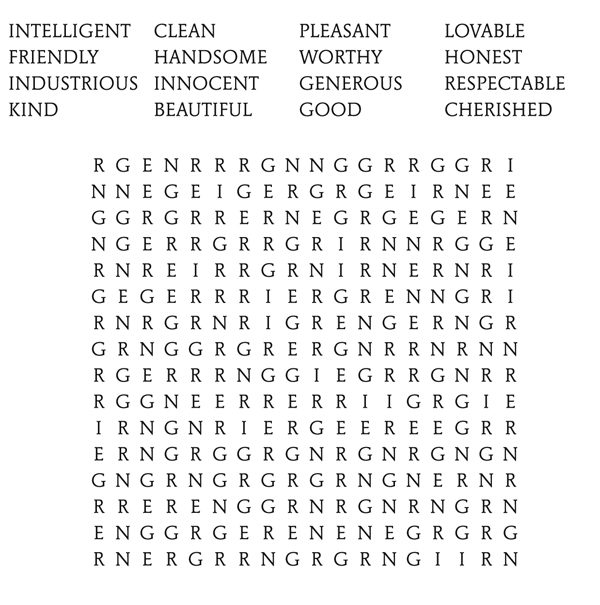
The following piece was presented as “5 Poems and 3 Notes” in the panel “Post Black? Culture, Craft, and Race in Verse” at the 2013 AWP Conference in Boston, Massachusetts. The panel was organized by Mitchell L. H. Douglas, and featured readings and remarks from poets Randall Horton, Khadijah Queen, and Douglas Kearney, along with myself. Mitchell Douglas conceived of the panel as a necessary extension of a conversation held at the previous year’s conference. His description of our panel began: “At AWP 2012, a panel of white identified poets examined race in poetry. But what do black poets, often accused of limiting the scope of their poems to race, have to say?”
I was honored to be among the fiercely talented poets he invited to respond to this question. I began by reading the poems listed below – all of which appear in my most recent collection, the new black (Wesleyan, 2011), and elaborated in prose “Notes” on some of the ideas raised by or embodied in my poetry. Please bear in mind that this piece was written for oral delivery and read with an ear for how tone shapes these words. I’m grateful to Brian Spears of The Rumpus, who was present, for the opportunity to share these remarks with those not able to attend.
Poems:
my last modernist poem, #4 (or, re-re-birth of a nation)
mesostics from the american grammar book
notes to my nieces (or, essays in fortune-telling)
Notes:
Our panel description reminds us that black poets are sometimes “accused of limiting the scope of [our] poems to race.”
1) Accused
We could also accuse U.S. poets of limiting the scope of our poems to America, or accuse Polish poets of limiting the scope of their poems to Poland, or accuse well-educated and more-or-less financially comfortable poets of limiting the scope of their poems to the concerns and perspectives of the middle class. These accusations would be equally true, equally false and misleading. Indeed, to call them accusations in the first place suggests that there is something inherently wrong with a poet writing poems that reveal her imaginative engagement with the material of the cultural worlds in which she finds herself located, with which she is most intimately familiar or to which she is most inextricably bound. In an era when young poets are routinely told that there is nothing outside the scope of poetry—nothing too mundane, nothing too unconventional—I would like to think that race is not an excluded or suspect subject. I would like to think that one’s poetry—whether a single poem, a book, or an oeuvre—cannot be “too black.”
2) Limiting
To say that black poets are “limiting our poems to race,” first implies that there’s a self-policing at work. Have there ever been black poets who very consciously chose to exclude subjects and forms from their work on the grounds that those subjects or form were not “black enough”? Why, yes, indeed! The classic example of such an approach would be found in the work of the Black Arts Movement. I would strongly encourage anyone interested in the subject of these notes to go and read BAM poetry in the context of the theories and manifestos published by writers and scholars who participated in it or studied it carefully. Only by engaging it can one fully understand what motivated this prescriptive position, or appreciate the intellectual and political—not to mention the aesthetic—work that was involved in BAM poetry. However, to speak of “black poets” as if all of us, past and present, share the imperatives of the BAM poets or embrace the Movement’s positions uncritically, you’d have to misread (or not read) the bulk of the African American poetry tradition, and that goes double for the work by black poets of other national or cultural backgrounds.
My sense is that most black poets do not place racialized prescriptions on their subject matter or formal approaches, though many of us are at times very interested in bringing race or blackness into poems in ways that will reach particular or multiple audiences. But, more importantly, it must be said that focusing on race or blackness does not “limit” one’s poetry, in the sense of containing it in a narrow field. Race doesn’t operate in a social vacuum. Black cultures are not produced or sustained in isolation. Thus, when we write about race or blackness, we have by definition, a vast canvas upon which to paint. The poems I read today are “about race” or “about black culture,” but they are also and equally “about gender,” “about sexuality,” “about history,” “about family,” and “about the U.S.” They employ formal devices and structures that I have absorbed from reading and listening to black poets and from my black cultural experiences more broadly, but they also incorporate moves that come from other traditions and other aspects of my background. Poetry “about race” and “about blackness” includes work as aesthetically and thematically varied as the neat quatrains of George Moses Horton’s laments, the lazy sway of Langston Hughes’s blues poems, the intricate sonnets of Gwendolyn Brooks, the clipped parataxis of Erica Hunt, and the sonic acrobatics of Tracie Morris, just for starters.

3) Race
It has become increasingly important in recent years for me to stress that “race” and “blackness” are not interchangeable terms. To write about race is to write about the creation and perpetuation of racial categories (of which “black” is only one), and to consider the ways those categories have been used to arrange and manage our societies around an inequitable distribution of opportunities, resources, rights, and privileges (to put it generously). To write about blackness is to write about a cultural formation that emerged from the crucible of racism, but far exceeds the fact of racial subjection, oppression, and discrimination, encompassing ways of being that are as rich, as funny, as philosophical, as moving, as poignant, and as inventive as those of any culture on the planet. Writing about race and writing about blackness are often conflated with each other, as in the phrase I’ve been dissecting, when instead they come together in a Venn diagram sort of way, overlapping but not encompassing one another.
There is so much more I could say on this subject, given more time. But for now, I will close with the briefest of gestures towards the relationship between “blackness” and poetic innovation, about which I’ve written at length elsewhere. Not to contradict what I said earlier about “race” and “blackness” not being limiting, we might nonetheless think about them as analogous to poetic constraints, which I, for one, find incredibly generative. Think, for instance, of the stanza, which we know is Italian for “little room.” Think of “blackness” as another such room, a generous space in which to create, with windows onto everything, and an open door.




